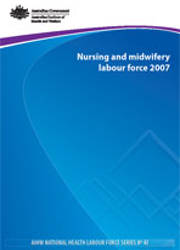Summary
Summary
This report provides information on the nursing and midwifery labour force, based primarily on estimates derived from the 2007 Australian Institute of Health and Welfare (AIHW) Nursing and Midwifery Labour Force Survey. This survey collects information on the demographic and employment characteristics of nurses and midwives who were registered or enrolled in Australia at the time of the survey. It is conducted annually by state and territory health departments, with the questionnaire administered in most jurisdictions by the nursing and midwifery registration boards, in conjunction with the registration renewal process. It should be noted that the figures in this report are estimates, and should be interpreted carefully due to declining response rates and changes to the survey form over time.
The main findings of the report are as follows:
- Overall, nursing supply increased by 7.6% between 2003 and 2007, from 1,017 full-time equivalent nurses per 100,000 population to 1,095 full-time equivalent nurses per 100,000 population based on a 38-hour week. This was mainly a result of both an 11.3% increase in the number of employed nurses and a 2.5% increase in the average hours they worked over this period.
- In 2007, the total number of nurses identified by the Nursing and Midwifery Labour Force Survey (after adjusting for multiple registrations) was estimated to be 305,834, comprising 245,491 registered nurses and 60,343 enrolled nurses.
- The number of registered and enrolled nurses increased by 11.9% between 2003 and 2007.
- Between 2003 and 2007, the number of nurses actually employed in nursing increased by 11.3%, from 236,645 to 263,331.
- The average weekly hours worked by employed nurses and midwives increased from 32.5 hours in 2003 to 33.3 hours in 2007. Over the same period, the proportion of nurses working part-time (less than 35 hours per week) declined from 50.1% to 48.1%.
- Nursing supply across regions ranged from 1,028 full-time equivalent nurses per 100,000 population in Major cities to 1,115 in Remote areas based on a 38-hour week.
- The nursing workforce continued to age. Between 2003 and 2007, the proportion of nurses aged 50 years or over increased from 28.2% to 33.0%.
- Nursing continued to be a female-dominated profession, with females comprising 90.4% of employed nurses in 2007 (down from 91.4% in 2003).
- The overall response rate to the 2007 survey was estimated to be 49.6%; however, there was considerable variation in response rates across the states and territories.
Estimates in this report may vary from workforce estimates produced by individual jurisdictions, as the AIHW removes nurses and midwives who work mainly or only in another jurisdiction from state and territory estimates, and due to differences in imputation and estimation processes.



